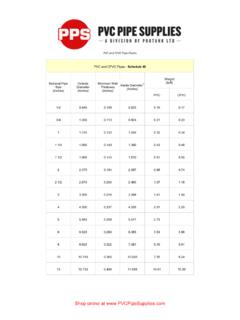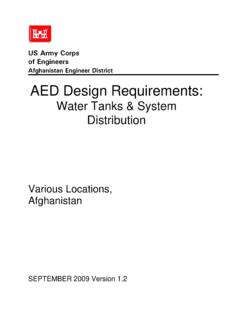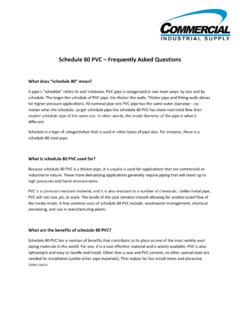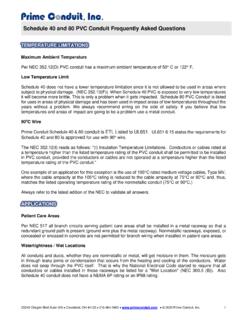Transcription of Engineering Design Data - PVC Pipe, PVC Fittings & PVC …
1 2012 Georg Fischer Harvel LLC 300 Kuebler Road, Easton, PA 18040 610-252-7355 Fax: 610-253-4436 & CPVC Corrosion Resistant Industrial Pressure PipeEngineering & Design DataEngineering & Design DataHydraulic ShockHydraulic shock is the term used to describe the momentary pressure rise in a piping system which results when the liquid isstarted or stopped quickly. This pressure rise is caused by themomentum of the fluid; therefore, the pressure rise increases withthe velocity of the liquid, the length of the system from the fluidsource, or with an increase in the speed with which it is started orstopped. Examples of situations where hydraulic shock can occurare valves, which are opened or closed quickly, or pumps, whichstart with an empty discharge line.
2 Hydraulic shock can even occurif a high speed wall of liquid (as from a starting pump) hits a sudden change of direction in the piping, such as an elbow. Thepressure rise created by the hydraulic shock effect is added towhatever fluid pressure exists in the piping system and, althoughonly momentary, this shock load can be enough to burst pipe and break Fittings or formula, which closely predicts hydraulic shock effects is:Where:p =maximum surge pressure, psiv =fluid velocity in feet per secondC =surge wave constant for water at 73 F*SG = specific gravity of liquid ( If SG is 1, then p = VC )Example: A 2" PVC schedule 80 pipe carries a fluid with a specificgravity of at a rate of 30 gpm and at a line pressure of 160 would the surge pressure be if a valve were suddenly closed?
3 From table 1: C = =( ) ( ) = 88 psi Total line pressure = 88 + 160 = 248 psiSchedule 80 2" PVC has a pressure rating of 400 psi at room , 2" schedule 80 PVC pipe is acceptable for this total pressure at any time in a pressure-type system (operating plus surge or water hammer) should not exceed 150 percent of the pressure rating of the I - C-Surge Wave Constant pipe Size PVCCPVC(in.)Sch. 40 Sch. 80 Sch. 40 Sch. 801 Design when laying out a piping system will eliminate the possibility of hydraulic shock following suggestions will help in avoiding problems:1. In a plastic piping system, a fluid velocity not exceeding 5 will minimize hydraulic shock effects, even with quickly closing valves, such as solenoid Using actuated valves which have a specific closing time willeliminate the possibility of someone inadvertently slamming a valve open or closed too quickly.
4 With pneumatic and air-spring actuators, it may be necessary to place a valve in the airline to slow down the valve operation If possible, when starting a pump, partially close the valve inthe discharge line to minimize the volume of liquid, which israpidly accelerating through the system. Once the pump is upto speed and the line completely full, the valve may be A check valve installed near a pump in the discharge line willkeep the line full and help prevent excessive hydraulic shockduring pump ExampleCompensating for Expand & ContractCTS + + 2012 Georg Fischer Harvel LLC 300 Kuebler Road, Easton, PA 18040 610-252-7355 Fax.
5 610-253-4436 & CPVC Corrosion Resistant Industrial Pressure PipeEngineering & Design (1)(3)(3)(2) Loss CharacteristicsHead Loss Characteristics of WaterFlow Through Rigid Plastic pipe NomographThe nomograph on the following page provides approxi-mate values for a wide range of plastic pipe sizes. More precise values should be calculated from the Williams &Hazen formula. Experimental test value of C (a constant forinside pipe roughness) ranges from 155 to 165 for varioustypes of plastic pipe . Use of a value of 150 will ensure con-servative friction loss values. Since directional changes andrestrictions contribute the most head loss, use of head lossdata for comparable metal valves and Fittings will provideconservative values when actual values for PVC and CPVC Fittings and valves are not & Hazen :f =Friction head in feet of water per 100 feetd =Inside diameter of pipe in inchesg =Flowing gallons per minuteC =Constant for inside roughness of the pipe (C = 150 for thermoplastic pipe )The nomograph is used by lining up values on the scales by means of a ruler or straight edge.
6 Two independent variables must be set to obtain the other values. For example line (1) indicates that 500 gallons per minute may be obtained with a 6-inch inside diameter pipe at ahead loss of about pounds per square inch at a velocityof feet per second. Line (2) indicates that a pipe with inch inside diameter will give a flow of about 60 gallonsper minute at a loss in head of 2 pounds per square inchper 100 feet of pipe . Line (3) and dotted line (3) show thatin going from a pipe inside diameter to one of 2inches inside diameter the head loss goes from 3 to 4pounds per square inch in obtaining a flow of 70 gallons per minute.
7 Flow velocities in excess of feet per secondare not courtesy of Plastics pipe Institute,a division of The Society of The Plastics for Expand & ContractCTS plumbing3ED( L) + 2012 Georg Fischer Harvel LLC 300 Kuebler Road, Easton, PA 18040 610-252-7355 Fax: 610-253-4436 & CPVC Corrosion Resistant Industrial Pressure PipeEngineering & Design DataFlow Velocity & Friction LossFriction LossFriction loss through PVC and CPVC pipe is most commonlyobtained by the use of the Hazen-Williams equations as expressedbelow for water:Where: f = friction head of feet of water per 100' for the specificpipe size and =a constant for internal pipe roughness.
8 150 is the commonlyaccepted value for PVC and CPVC =flow rate of gallons per minute ( gallons).di = inside diameter of pipe in to other materials on construction for pipe , thermoplastic pipe smoothness remains relatively constantthroughout its service VelocitiesVelocities for water in feet per second at different GPM s and pipeinside diameters can be calculated as follows:Where: V = velocity in feet per secondG =gallons per minuteA =inside cross sectional areain square inches GF Harvel does not recommend flow velocities in excessof five feet per second for closed-end systems, particularly in pipe sizes 6"and larger.
9 Contact GF Harvel tech services for additional BlockingIn addition to limiting velocities to 5'/sec., especially with largerdiameters (6" and above), consideration should be given to stresses induced with intermittent pump operation, quick openingvalves and back flow in elevated discharge lines. Use of bypass piping with electrically actuated time cycle valves or variable speedpumps and check valves on the discharge side are suggested withthe higher GPM rates. Thrust blocking should be considered fordirectional changes and pump operations in buried lines 10" andabove, particularly where fabricated Fittings are utilized.
10 Abovegrade installations 10" and above should have equivalent bracing tosimulate thrust blocking at directional changes and for intermittentpump operations. Thrust blocking of directional changes and timecycle valves are also recommended for large diameter drain linesin installations such as large swimming pools and tanks. Use ofappropriate pump vibration dampers are also IN POUNDSFROM STATIC INTERNAL PRESSUREPipe Socket For Plug,For For For Joint90 EllSizeDepth60 Ell, 45 90 (in.)(in.)Cap TeeEllEllEllTo Thrust Factor667,1702,8005,48010,14037, ,2404,3808,59015,89048, ,2806,350 12,44023,02081, ,0408,990 17,60032,580102, ,61010,380 20,33037,630115, ,91013,620 26,67049,360150, ,29017,270 33,84062,630203, ,41016,54032,40059,970226, ,04023,810 46,64086,310316, depths are from ASTM D 2672 for belled-end PVC pressures utilized for the tabulation above are forSchedule 80 2"- 18" sizes and SDR 160 psi for 20" and 24" calculation for thrusts due to static internal pressure is:Thrust =x = for tees, 60 ells, plugs and caps.










